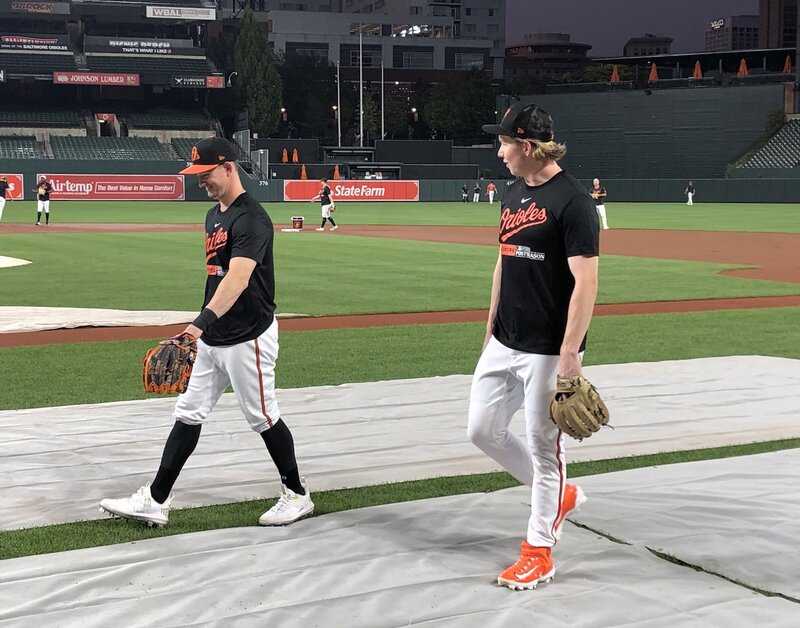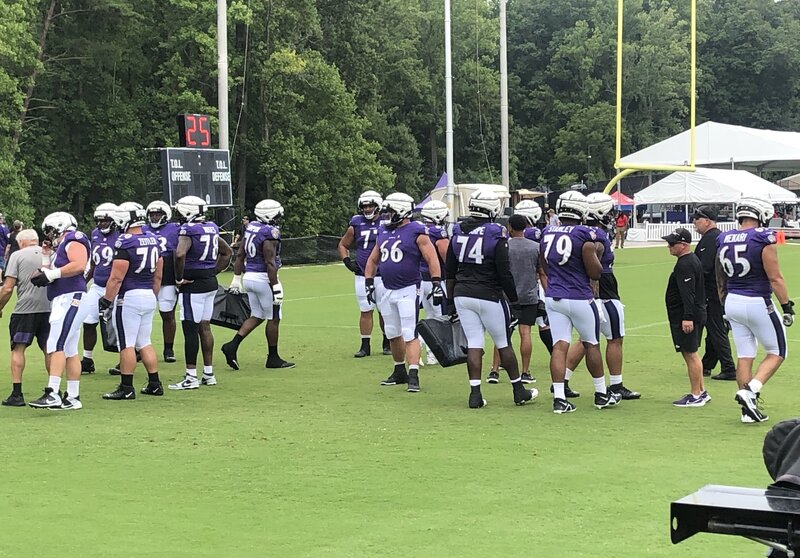Ravens general manager Eric DeCosta was swinging for the fences late Thursday night.
Making two first-round selections in a draft for the fifth time in the 26-year history of the franchise, the Ravens took different risks with Minnesota wide receiver Rashod Bateman and Penn State edge defender Odafe Oweh, each with a chance to have a significant impact on their Super Bowl chances in 2021 and beyond.
Though Bateman is as clean a wide receiver prospect as you could reasonably expect to find with the 27th overall pick, the first-round bust rate at the position is no secret, and the Ravens had other positions they could have addressed early on. That the only team in NFL history to rush for more than 3,000 yards in back-to-back seasons has now drafted a wide receiver in the first round in two of the last three years reflects a commitment to try to take the next step in the passing game. Acknowledging a few years ago that the organization hadn’t taken enough swings drafting wide receivers after selecting just three in the first round over their first 23 years and using only two top-100 picks on the position during the entire Joe Flacco era (2008-18), DeCosta has now drafted four wide receivers in the first three rounds of his first three drafts as general manager — assuming he doesn’t grab another Friday night.
Despite the punch lines and disenchantment expressed by ex-Ravens wide receivers on social media this offseason, Baltimore didn’t draft Bateman in the first round to be a decoy and blocker. On paper, the 6-foot, 190-pound wideout finally gives star quarterback Lamar Jackson an outside receiving option who runs crisp routes, beats press coverage, and makes contested catches. Of course, we’ll see how it translates for the 21-year-old Bateman — who’s been compared by some to four-time Pro Bowl selection Keenan Allen — and an offense that ran the ball 55 percent of the time in 2020.
Having difficulty signing a high-profile wide receiver before inking the oft-injured Sammy Watkins to a one-year deal a couple weeks into free agency, DeCosta hopes he’s instead drafted one. But if Bateman doesn’t work out, the perception that this run-heavy offense isn’t friendly to wide receivers will only gain steam, making one wonder if the Ravens will ever get over the January hump with such a unique playing style.
On the other side of the ball, Oweh brings a different kind of risk as the first outside linebacker drafted by the Ravens in the first round since Terrell Suggs in 2003. Having traditionally targeted later-round prospects or very productive college pass rushers like Suggs and 2019 third-round pick Jaylon Ferguson, Baltimore selected one of the biggest boom-or-bust prospects in the entire draft over other edge options arguably owning higher floors. Fully acknowledging the 6-foot-5, 257-pound Oweh’s remarkable physical tools and disruptive play that didn’t appear on the stat sheet at Penn State, taking an edge defender who had as many sacks as you and me last season is quite the leap of faith for a first-round selection.
Yes, the Ravens have a long history of developing pass rushers — in many cases, just in time for them to sign big free-agent deals elsewhere — but the urgency is different now after the free-agent departures of Matthew Judon, Yannick Ngakoue, and Jihad Ward. While the presence of veteran Pernell McPhee and Ferguson may not make it necessary for Oweh — who’s only been playing football since 2016 — to be an immediate starter and three-down player, the Ravens will need the rookie to be a meaningful part of the game-day rotation to boost a pass rush so dependent on the blitz. A Super Bowl contender can’t afford to have a first-round pick be another slow developer like Paul Kruger, Za’Darius Smith, or Tyus Bowser.
Supporters of the Oweh pick will point no further than Minnesota’s 2015 third-round selection of edge rusher Danielle Hunter after the LSU product managed just 4 1/2 sacks in his collegiate career, fewer than Oweh’s seven over three seasons in Happy Valley. The 6-foot-5, 252-pound Hunter would explode at the next level to collect 54 1/2 sacks and make two Pro Bowls over his first five seasons with the Vikings, making that lack of college sack production a distant memory.
Of course, we also recall past workout warriors like Mike Mamula and Solomon Thomas not coming close to living up to their draft status.
With many anticipating the Ravens going in other directions in the first round — for example, an offensive lineman is always perceived as a safer selection — or even trading back with one of those picks to accumulate later draft choices, DeCosta stayed put and aimed to maximize the upside for his passing offense and the outside linebacker position. There are always alternatives to consider — and rarely only one correct path — but the draft is becoming even more critical with an expensive roster that will soon include a quarterback with a nine-figure contract. Nothing is guaranteed, but Bateman and Oweh have the potential to blossom into inexpensive young stars, something the Ravens struggled to find in the early years of the post-Super Bowl Flacco era before it caught up with them a few years later.
Ultimately, DeCosta knows you can’t hit any home runs unless you take some big swings, something the Ravens certainly did on Thursday night.






























